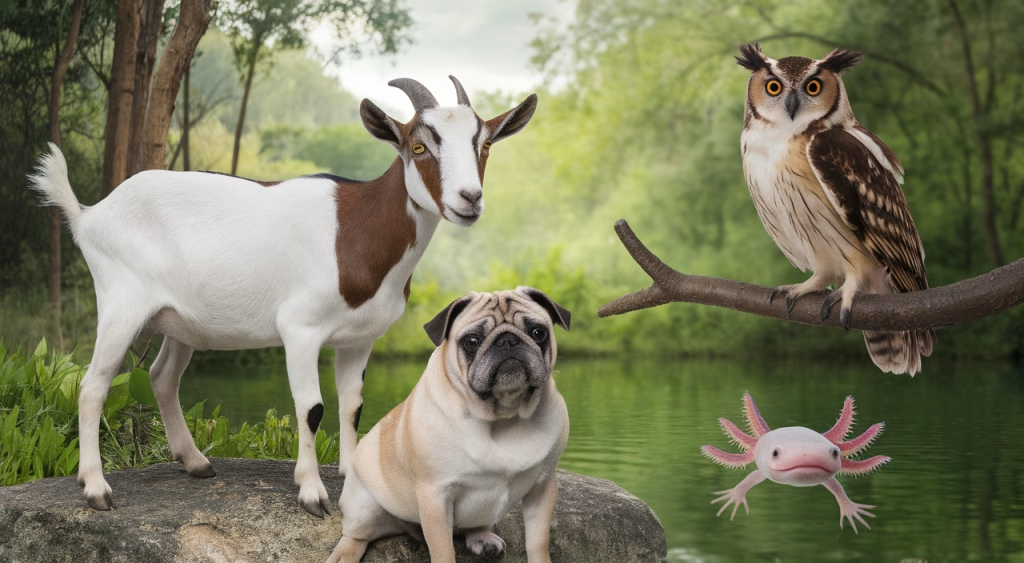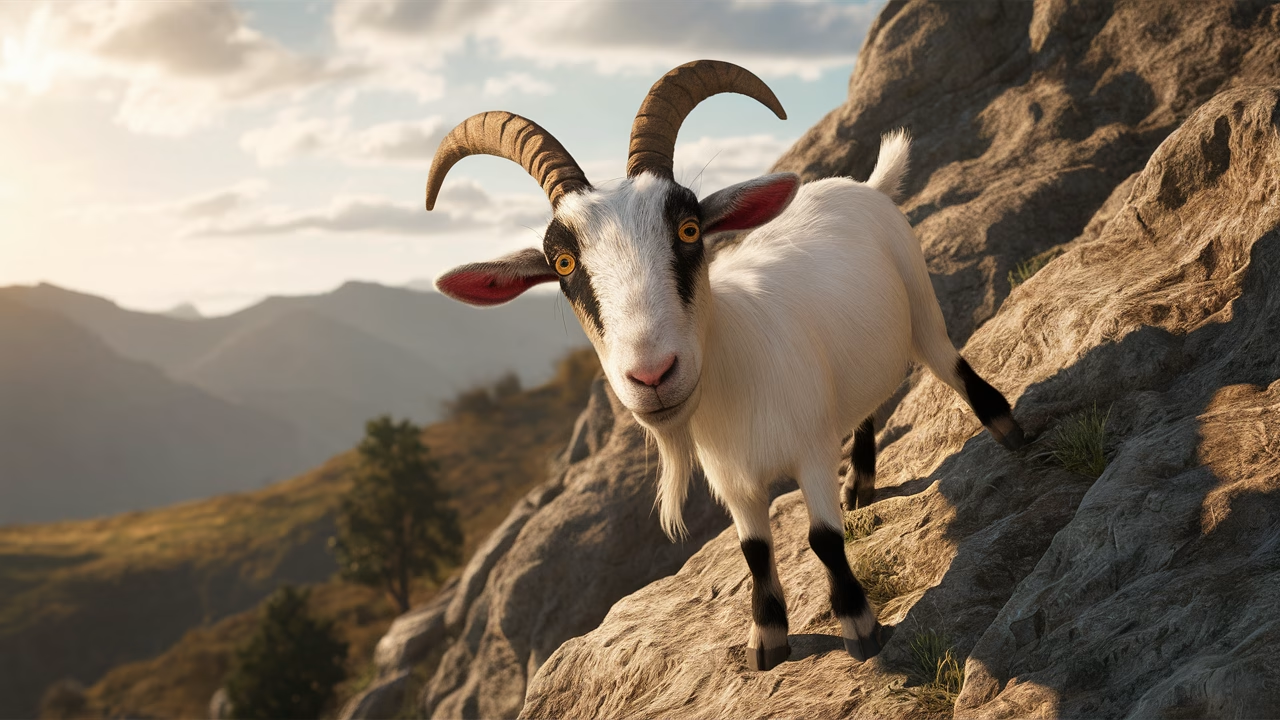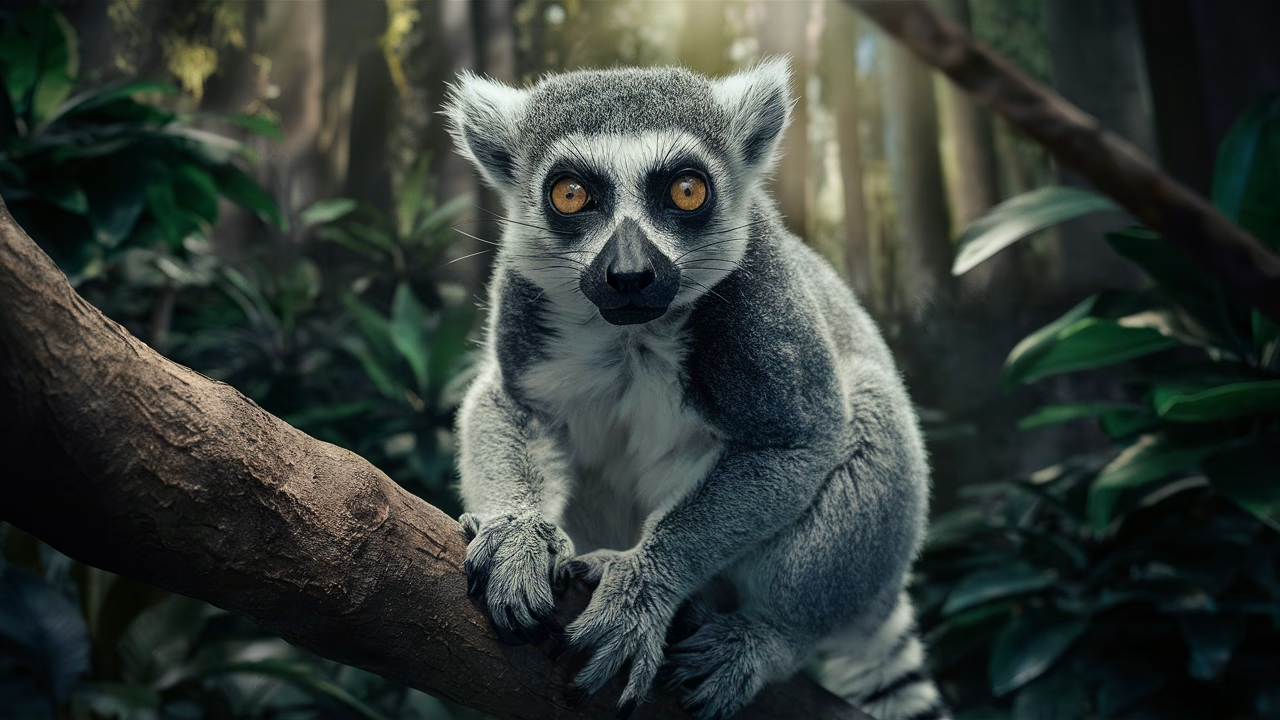Why Do Some Animals Always Look So Confused?
Some confused animals wear bewilderment like it’s their signature look. But those puzzled expressions? They’re often the result of unique anatomy, survival behaviors, or human interpretation. Their hilariously confused faces might seem like comedy gold, but there’s fascinating science behind those blank stares and head tilts.
- Goats: With rectangular pupils, they always look skeptical — because their vision literally warps the world.
- Owls: Huge eyes fixed in place force them to swivel their heads, creating that signature stunned look.
- Frogs: Bulging eyes and motionless pauses make them look perpetually perplexed — it’s survival in disguise.
- Goldfish: Their expressions scream “What was I doing again?” — but their memory is way sharper than the myths suggest.
- Axolotls: Constantly look amazed, but behind the smile they’re masters of regeneration science.
Many confused animals display these expressions due to specific evolutionary traits — facial structure, eye positioning, or behavioral survival instincts. And while they tickle our funny bone, they’re also a doorway into understanding how animals adapt. So stay with us as we celebrate the wonderfully whimsical world of confused animals and explore the science that shapes their most iconic expressions.
The Science Behind Confused Animals: Anatomy Meets Expression
Let’s start with the basics: why do some animals look like they’ve just wandered into the wrong documentary?
In many cases, it’s anatomy doing the heavy lifting. Take goats, for instance. Their eyes feature rectangular pupils — a rare trait — which gives them panoramic vision. This unique ocular structure helps them scan for predators while grazing, but on a fluffy four-legged face, it screams confusion and suspicion. Similarly, pugs sport compressed skulls (thanks to selective breeding), exaggerating their facial expressions into what we lovingly call “panic potato mode.”
Now, about owls. Their eyes are fixed in their sockets. They literally can’t move them. To compensate, they evolved necks capable of nearly 270° rotation — an unsettlingly calm, exaggerated motion that, combined with their feathered brows and forward-facing gaze, results in a majestic deer-in-the-headlights look. It’s science wrapped in dramatics.
But it’s not all in the bone structure. Behavior plays a major role in how confused animals appear to us. Sloths process information slowly, giving them a sleepy disposition. Lemurs dart their eyes and heads rapidly — a sign of hyper-awareness — but to us, it paints a picture of someone who just witnessed a scandal.
Here’s the kicker: what looks like confusion to us is often an adaptive trait. Evolution didn’t select for “looking bewildered” — it just happens to be a side-effect of the adaptations that help animals thrive.
A Closer Look: Who’s on the Confused Animal Hall of Fame?
There are dozens of confused animals that have earned legendary status for embodying maximum bewilderment. Let’s take a peek at the top contenders, and the science behind their endearing derp.
| Animal | Why They Look Confused | What’s Really Going On |
|---|---|---|
| Goats | Rectangular pupils and stiff posture | Excellent vision for predator scanning |
| Owls | Fixed eyes, head rotation, slow reaction blink | Focused predators with superb hearing |
| Axolotls | Permanent grin and feathery gills | Master regenerators with unique youth retention (neoteny) |
| Sloths | Slow motion blinks and droopy faces | Low-metabolism survival in predator zones |
| Goldfish | Bulging eyes and blank stares | Better memory than myth, cautious of stimuli |
The Behavioral Quirks Behind the Puzzled Faces
Ever stare at your cat mid-wall-graze wondering if they were seeing ghosts? Sometimes animal behavior enhances their confused presentation.
For example, pugs twitch their ears, snort, and tilt their heads at unpredictable sounds — behaviors rooted in their strong and sensitive hearing. Combine that with their facial structure, and they appear perpetually unsure.
Axolotls, on the other hand, simply float about in their tanks with their little Mona Lisa smiles, not reacting much. That expressionless chill isn’t ignorance — it’s because they’re cold-blooded and incredibly efficient with energy. Most amphibians conserve movement unless actively hunting.
Meanwhile, cats often freeze mid-action with dilated pupils — a predator’s focus. They’re not stuck — they’re calculating. But to us? It reads like a feline existential crisis among the most confused animals in our homes.
Case Study: Why Do Octopuses Have Blue Blood?
One of our favorite misunderstood marine creatures — the octopus — isn’t often thought of as confused-looking, but its physiology sparks questions. Notably: why do octopuses have blue blood?
The answer lies in their copper-rich blood protein, hemocyanin. Unlike our iron-based hemoglobin (which gives our blood a red color), hemocyanin binds with oxygen differently, and turns blue when oxygenated. This adaptation enables octopuses to efficiently transport oxygen in cold, low-oxygen ocean environments.
The presence of copper-based hemocyanin may make them unique, but how is this linked to their expressions? Octopuses change skin texture and color through chromatophores — cells that react instantly to stimuli. This sometimes creates facial patterns that resemble human confusion — particularly when camouflage is transitioning. But again, it’s not confusion — it’s high-level adaptive tech built into their biology.
Why Do Octopuses Have Blue Blood? The Fascinating Science Behind Hemocyanin
From Pugs to Lemurs: What’s the Evolutionary Point?
Why do so many confused animals share traits that read as comically puzzled to us? From an evolutionary standpoint, it wasn’t about looking adorable — these traits serve real biological purposes:
- Wide Eyes: Better peripheral vision, common in prey animals like goldfish and frogs.
- Facial Flattening: Selective breeding, especially in dogs like pugs or Peekinese, for “baby-like” features humans adore (known as neoteny).
- Stillness: Seen in owls and sloths — staying still decreases attention from predators or aids in effective stalking.
In short: what appears confused to us, is usually nature’s answer to “how do I stay alive out there?”
Are We the Ones Projecting Confusion Onto Animals?
Here’s where things get meta. Are confused animals actually confused — or are we just reading human emotions into their behavior? This concept is called anthropomorphism. It’s our tendency to interpret animal behaviors using human logic and emotion.
When you see a baby owl blinking slowly with fluffed-up feathers, your brain may go “He’s overwhelmed!” — because that’s how people look when tired or stunned. But in reality, that owl is processing information in the most owl-way possible: silently, motionlessly, and patiently.
This doesn’t make our interpretations any less fun. Just remember, their faces may mislead us — yet their survival skills are often far sharper than ours.
Comparing Facial Expression Origins in Confused-Looking Animals
| Animal | Expression Cause | Underlying Function |
|---|---|---|
| Pug | Flatter snout + big eyes | Breed traits enhance expressive cues |
| Goldfish | Unblinking eyes + gape | Adapted for aquatic vision |
| Lemur | Darting glances + open mouth | High-alert in social species |
| Sloth | Slow reactions | Low-energy survival mode |
TL;DR: Our Takeaway from the World’s Most Confused Animals
- Confusion is in the eye of the beholder. Most confused animals just look baffled — they aren’t actually lost.
- Anatomy drives expression. Unique eyes, facial shapes, and postures contribute to “confused” looks.
- Behavior influences perception. Stillness, slow reaction, or sudden head tilts read as puzzlement to us humans.
- These animals are often incredibly well-adapted survivors — from regenerative axolotls to night-hunting owls.
- Our interpretations are part science, part projection — and 100% affectionate.
So next time you spot a bewildered goat or a sloth lost in thought, remember — they might be living their best life, while we’re the ones decoding it with a chuckle.
Frequently Asked Questions
- Why do animals look confused?
Many expressions that appear confused are due to specific anatomical and behavioral traits adapted for survival. We’re often anthropomorphizing. - Are confused animals actually less intelligent?
No. Many of these species are highly skilled and adapted — confusion is an appearance, not a mental deficiency. - What is hemocyanin and why does it make octopus blood blue?
Hemocyanin is a copper-based protein used to transport oxygen in octopuses, giving their blood a blue hue when oxygenated. - Do goldfish really have a 3-second memory?
No. That’s a myth. Studies show goldfish have memory spans lasting several months. - Are pugs’ faces a result of evolution?
Not natural evolution, but human-directed selective breeding aiming for exaggerated neoteny traits.





